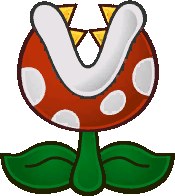Piranha Plant (Paper Mario: The Thousand-Year Door)
| The Thousand-Year Door enemy | |||||||||||||||||||||||||||||
|---|---|---|---|---|---|---|---|---|---|---|---|---|---|---|---|---|---|---|---|---|---|---|---|---|---|---|---|---|---|
| Piranha Plant | |||||||||||||||||||||||||||||

| |||||||||||||||||||||||||||||
| Location(s) | Pit of 100 Trials (Levels 81, 83-86, 88, 89) | ||||||||||||||||||||||||||||
| Max HP | 15 | ||||||||||||||||||||||||||||
| Attack | 9 | ||||||||||||||||||||||||||||
| Defense | 0 | ||||||||||||||||||||||||||||
| Moves | Jaw Clamp (9) | ||||||||||||||||||||||||||||
| Items | None | ||||||||||||||||||||||||||||
| Coins | 1 - 4 | ||||||||||||||||||||||||||||
| Log | The strongest of the Piranha Plants. It likes to live... in pipes. | ||||||||||||||||||||||||||||
| |||||||||||||||||||||||||||||
| |||||||||||||||||||||||||||||
| Tattle Log #: 59 | |||||||||||||||||||||||||||||
Piranha Plants are enemies found in Paper Mario: The Thousand-Year Door. They are the strongest of all Piranha Plants and like to live in pipes, as indicated in the Tattle Log, despite the fact that no Piranha Plants of this variety appear in pipes (though this more likely references the regular Piranha Plants from the Super Mario series).
History
Paper Mario: The Thousand-Year Door
This variant of Piranha Plant has the second-highest statistical attack power in the game, exceeded only by an Amazy Dayzee, which is 20. It also has absurdly high HP, only being beaten out by a handful of non-bosses, such as Dark Craws and Dark Koopatrols. Despite their toughness, they are easily put to sleep, incapacitating them for a few turns. They also have a good chance to be confused, possibly making them attack other enemies with massive strength.
Piranha Plants are rare in Paper Mario: The Thousand-Year Door, found only in the Pit of 100 Trials in floors 81-89.
Super Smash Bros. Ultimate
In Super Smash Bros. Ultimate, "Killer Pakkun" is mentioned briefly by Viridi during the Japanese Palutena's Guidance dialogue for Piranha Plant. It does not get a respective mention in the English version, like Fire Nipper Plant and the generic "Pakkun."
Names in other languages
| Language | Name | Meaning | Notes |
|---|---|---|---|
| Japanese | キラーパックン[?] Kirā Pakkun |
Killer Piranha | |
| German | Killer-Piranha[?] | Killer Piranha |
Trivia
- The respective internal file names for this Piranha Plant and Pale Piranhas (considered the "normal" Piranha Plants for this game in Japan) indicate that at some point in development, these Piranha Plants were intended to be the "base" version of Piranha Plant while the final game's Pale Piranha was intended as a variant of it, explaining the usage of the original coloration as well as the English localization calling them "Piranha Plants" but acknowledging them as different from the "usual" Piranha Plants.[1]
References
- ^ c_pakflwr and c_pakflwr_t, respective file names for Piranha Plants and Pale Piranhas in Paper Mario: The Thousand-Year Door